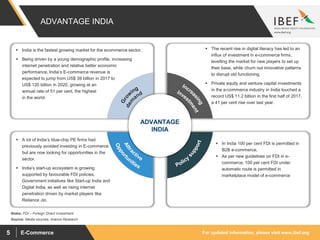The document provides an overview of the e-commerce industry in India. Some key points:
- The Indian e-commerce market is expected to grow from $38.5 billion in 2017 to $200 billion by 2026, surpassing the US.
- Rising internet penetration from 429 million users in 2017 to 829 million by 2021 will drive e-commerce growth.
- Electronics currently accounts for 47% of the e-commerce retail market, followed by apparel at 31%.
- The logistics sector supporting e-commerce is expected to grow from $460 million in 2016 to $2.2 billion by 2020.
- Major players like Flipkart, Amazon and Paytm are expanding product categories and

































